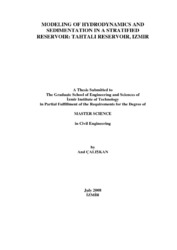Please use this identifier to cite or link to this item:
https://hdl.handle.net/11147/3782| Title: | Modeling of Hydrodynamics and Sedimentation in a Stratified Reservoir: Tahtalı Reservoir, Izmir | Authors: | Çalışkan, Anıl | Advisors: | Elçi, Şebnem | Publisher: | Izmir Institute of Technology Izmir Institute of Technology |
Abstract: | The main goal of this study was to investigate the hydrodynamics of a stratified reservoir for different flow and weather conditions through numerical modeling. This study also investigated the effects of selective withdrawal, climate change, and sediment deposition on hydrodynamics. A three-dimensional numerical model, Environmental Fluid Dynamics Code (EFDC) has been selected in the present study to model the hydrodynamics in the lake. The study site was selected as the main pool of Tahtali Reservoir providing 40% of the water used in the city of zmir (Population: 3.4 million by 2000). Applied numerical model was validated by monthly observations of water velocity and temperature profiles. Field measurements were performed from July 2006 to September 2007 in the lake and in two rivers (aal and Tahtali). The water velocity measurements in the lake were made using a 1.5-MHz acoustic Doppler current profiler. For water temperature and quality measurements, a hand-held water quality meter with a depth sensor were used for both lake and river measurements. Furthermore, a weather station was set up by the lake in order to collect accurate data for wind conditions in the study site.The numerical model predicted the observed velocity profiles and temperature time series satisfactorily. Possible reasons for discrepancies were investigated. Numerical model results indicated that water velocities were strongly dominated by the wind data and correct measurement of wind stress on the lake surface is necessary for accurate prediction of velocities in the water column. Withdrawal of the water at the bottom outlet was found to be the most effective choice encouraging the mixing of the water column. Possible climate change impacts modeled numerically indicated that the thermocline depths were lowered in the water column causing the deterioration of water quality. Sedimentation thickness was estimated via numerical modeling and the long term erosion rate was calculated by USLE method. Modeling the sedimentation zones provided valuable information on the capacity of the reservoir. The results of this study can be used to guide the further investigations in the lake including modeling of water quality for better management practices. | Description: | Thesis (Master)--Izmir Institute of Technology, Civil Engineering, Izmir, 2008 Includes bibliographical references (leaves: 82-88) Text in English; Abstract: Turkish and English xiii, 88 leaves |
URI: | http://hdl.handle.net/11147/3782 |
| Appears in Collections: | Master Degree / Yüksek Lisans Tezleri |
Files in This Item:
| File | Description | Size | Format | |
|---|---|---|---|---|
| T000673.pdf | MasterThesis | 7.13 MB | Adobe PDF |  View/Open |
CORE Recommender
Page view(s)
176
checked on Mar 31, 2025
Download(s)
90
checked on Mar 31, 2025
Google ScholarTM
Check
Items in GCRIS Repository are protected by copyright, with all rights reserved, unless otherwise indicated.